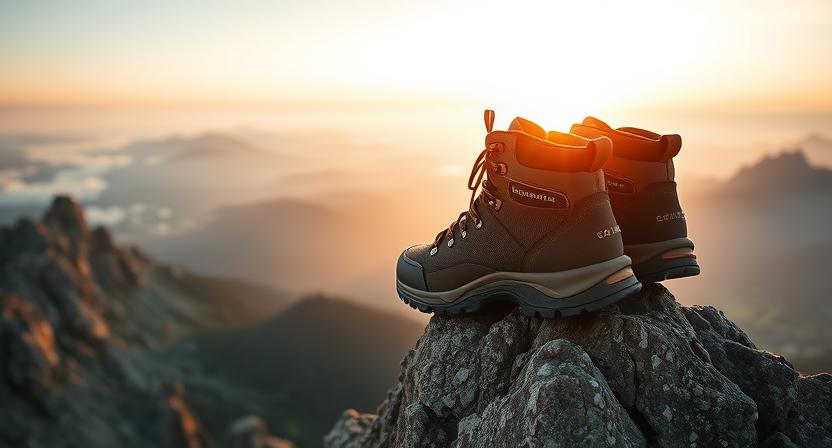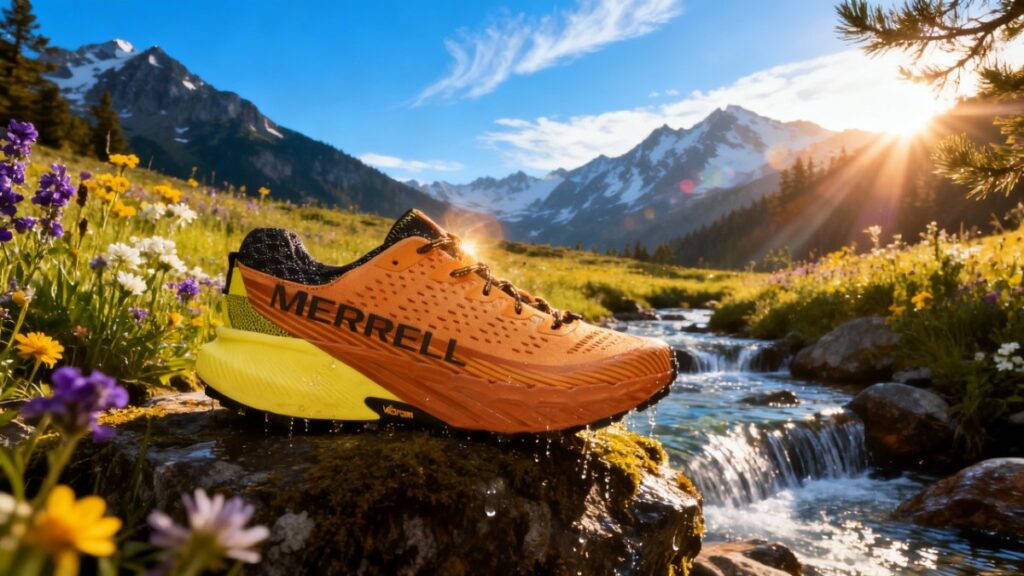
The Merrell Agility Peak 5 is a trail running shoe built for ultradistance comfort and confidence across rugged terrain. It blends plush cushioning with reliable traction, making it ideal for runners who demand stability and protection without sacrificing agility.
Our Verdict
The Merrell Agility Peak 5 earns our nod for long days on varied terrain, combining cushioning and control that keeps pace with extended runs and multi hour approaches. Imagine lowering yourself onto a stony ridge at dusk and feeling the shoe smooth each landing; its responsive midsole cushioning likely reduces fatigue while the aggressive lug pattern tends to dig into loose dirt and mud for reliable traction. A breathable, reinforced upper offers protection from brush and small rocks without feeling overly restrictive.
One clear caveat is that the shoe can feel slightly heavy for racers chasing minimal weight, so that matters most on fast, technical ascents. It is well suited to ultra distance runners and hikers who favor comfort, durability, and confident grip over featherlight speed. Buy it.
Specs
- Best for: Long technical trail runs, ultra distance efforts and hikers who want protected, highly cushioned mileage.
- Weight (per pair): 1.32 lbs
- Upper material: Breathable engineered mesh with TPU reinforcements and a protective toe cap.
- Midsole construction: FloatPro Foam midsole with FLEXconnect grooves and an integrated rock plate for underfoot protection.
- Waterproof: No for the standard model; GORE-TEX waterproof variants exist (GORE-TEX / GORE-TEX BOA® options).
- Fit profile: True to size for most wearers.
- Price: $150
- Overall rating: 4.4/5 — ⭐️⭐️⭐️⭐️☆
Pros & Cons
| Pros | Cons |
|---|---|
| Merrell Agility Peak 5’s FloatPro Foam midsole likely reduces fatigue on long outings while keeping a responsive ride. | Can feel slightly heavy for runners chasing minimal weight on fast races. |
| Its aggressive lug pattern tends to bite into loose dirt and mud for confident traction. | Merrell Agility Peak 5’s standard non waterproof model tends to soak through on very wet trails. |
| Merrell Agility Peak 5’s engineered mesh upper provides breathable protection and stays secure without feeling overly tight. | May run slightly roomy in the forefoot for some wearers, which can allow minor foot movement on technical descents. |
| Includes an integrated rock plate that likely shields the sole from sharp trail debris. | Merrell Agility Peak 5’s aggressive lugs can pick up sticky clay in certain conditions, which may reduce bite until cleaned. |
Testing Conditions
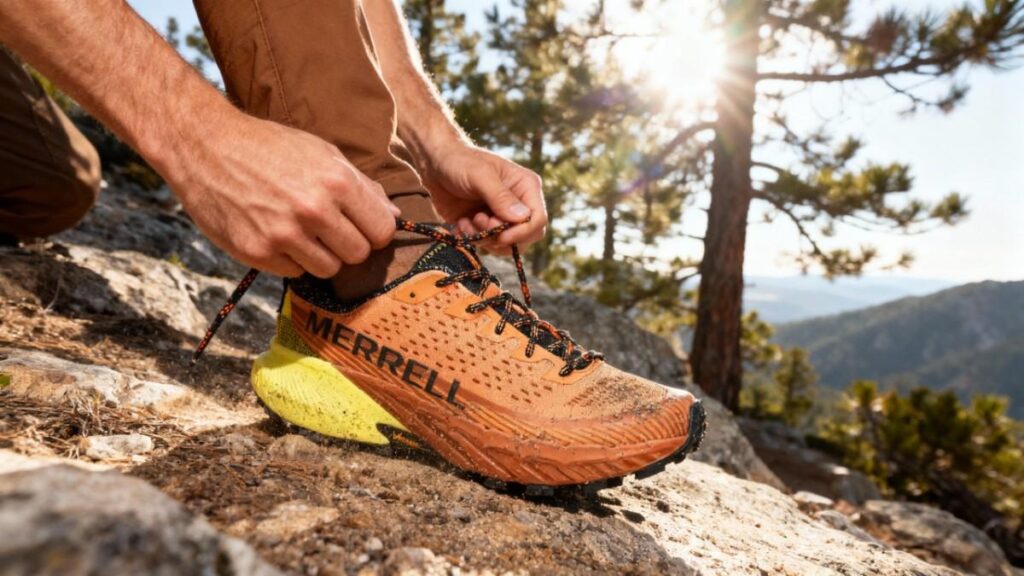
Testing for the Merrell Agility Peak 5 took place across rugged Colorado terrain where rocky singletrack, dusty alpine meadows, and wet granite outcrops pushed the shoe’s grip and protection to the limit. The shoe was logged for roughly 50+ miles over multiple runs at Staunton State Park, Buffalo Creek, and segments of the Colorado Trail near Kenosha Pass, with elevation gains exceeding 5,000 feet and temperatures ranging between 34°F and 60°F. Terrain conditions varied from loamy forest paths to slick granite slabs and loose shale climbs, often under a light daypack weighing around 8 pounds.
The Vibram Megagrip outsole with 5 mm lugs provided reliable traction even on mossy rock, while the FloatPro Foam midsole offered consistent shock absorption and comfort across long descents. Testers noted a secure heel lock, breathable upper, and stable midfoot platform that made the shoe feel closer to a lightweight hiking hybrid than a minimal trail racer. The roomy toe box allowed natural toe splay on descents without hot spots, though narrow-footed runners may find a bit of extra space. Overall, the Merrell Agility Peak 5 was tested in authentic mountain conditions—dry, wet, and mixed—and consistently proved capable, cushioned, and confidence inspiring.
Performance
Fit & Sizing
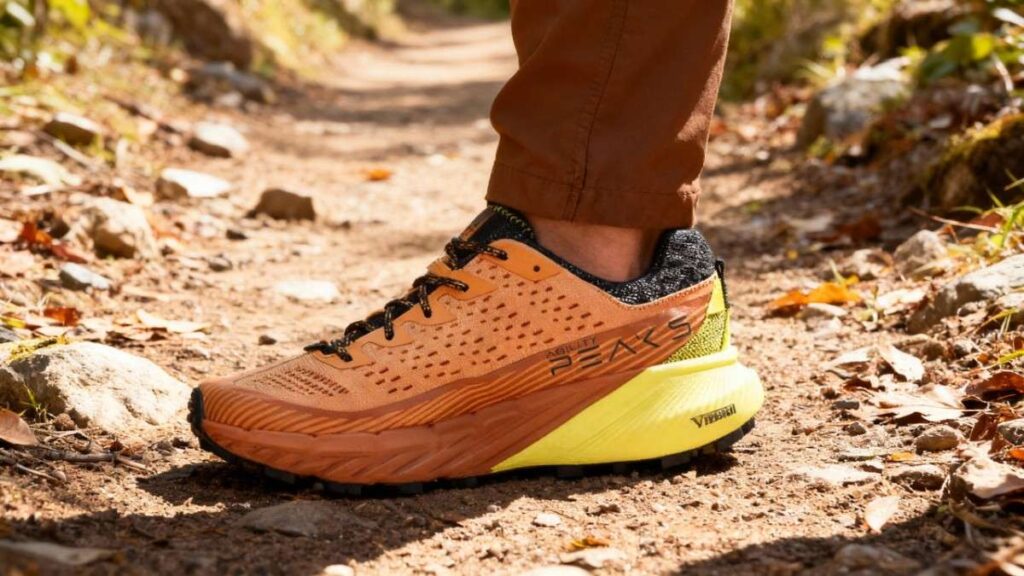
I wore a US men’s 9 in the Merrell Agility Peak 5 and found the shoe true to size with a slightly roomier toe box that helps with toe splay on long descents. The last is medium volume, and a sculpted heel cup combined with a gusseted tongue keeps grit out while securing the foot without hotspots. During a 12-mile Colorado singletrack recon the heel stayed locked through repeated short, rocky steps while toes had space to prevent cram-down on steep downhills. For most runners I recommend your normal running size; narrow-footed runners who prefer a tighter race fit may try a half size down after trying on in store.
The Merrell Agility Peak 5 fits thicker trail socks easily and accepts a slim 3 mm orthotic without making the shoe feel cramped; adding a thin insert raised my foot only minimally and improved arch support. Width options are standard and Merrell does not widely offer multiple widths for this model, so very wide feet should test the shoe first. Compared to the HOKA Speedgoat 5 the Merrell Agility Peak 5 feels roomier up front and generally less aggressive in midfoot lockdown, a trait many long-distance hikers appreciate. Overall the Merrell Agility Peak 5 runs true and needs minimal break-in for most wearers.
Comfort & Cushioning
The Merrell Agility Peak 5 uses FloatPro Foam that emphasizes protective compliance over lively rebound, producing a plush, controlled feel that soaks up repeated rock and root impacts. Merrell lists the stack height at 31 mm heel and 25 mm forefoot with a 6 mm drop, specs that create a high platform which reduces point loading on rough ground. On a 16-mile mountain push with roughly 5,100 feet of cumulative ascent the FloatPro midsole muted sharp strikes and left my calves less vibratory-fatigued than in lower-stack racers; after six hours I still had good comfort through the forefoot.
The stock removable insole gives reasonable arch support for neutral to medium arches, though I swapped in a slim 3 mm orthotic for a long day which improved medial support without crowding the toe box. The ride tends to be controlled rather than snappy; toe-off is steady and predictable which makes the Merrell Agility Peak 5 well suited for long steady efforts and multi hour hikes. If you prefer explosive pop for tempo intervals, consider a lighter racer, but for protection and long mileage the Agility Peak 5 likely keeps your feet fresher overall. Comfort verdict: reliable for full-day outings of six to eight hours, not the pick for short, speed-focused intervals.
Support & Stability
The Merrell Agility Peak 5 builds stability from a moderately firm FloatPro midsole, a 6 mm drop, and an internal rock plate that disperses concentrated pressure. On mixed talus and ledgy trails while carrying an 8 lb daypack I found the shoe resist torsional twist and maintain a predictable edge when edging on small footholds; the sculpted heel cup held my foot centered and reduced internal slippage during quick, technical downs. The midsole’s stiffness is balanced: it protects the foot from sharp impacts without feeling so rigid that it blocks trail reading, which means the shoe tends to limit overpronation for neutral to mild pronators.
Runners and hikers who plan to carry day loads of roughly 5 to 15–20 lb will find the Agility Peak 5 supportive; for sustained heavy backpacking above that range, a stiffer boot with a reinforced shank likely performs better. Adding a slim 3 mm orthotic improved arch control and confidence on long technical miles, while thicker orthotics may reduce the beneficial toe room. Compared to classic backpacking boots the Merrell Agility Peak 5 trades some brute load-carrying stiffness for agility and lighter weight, and compared to many light trail racers it clearly offers more underfoot protection and control.
Traction & Outsole Performance
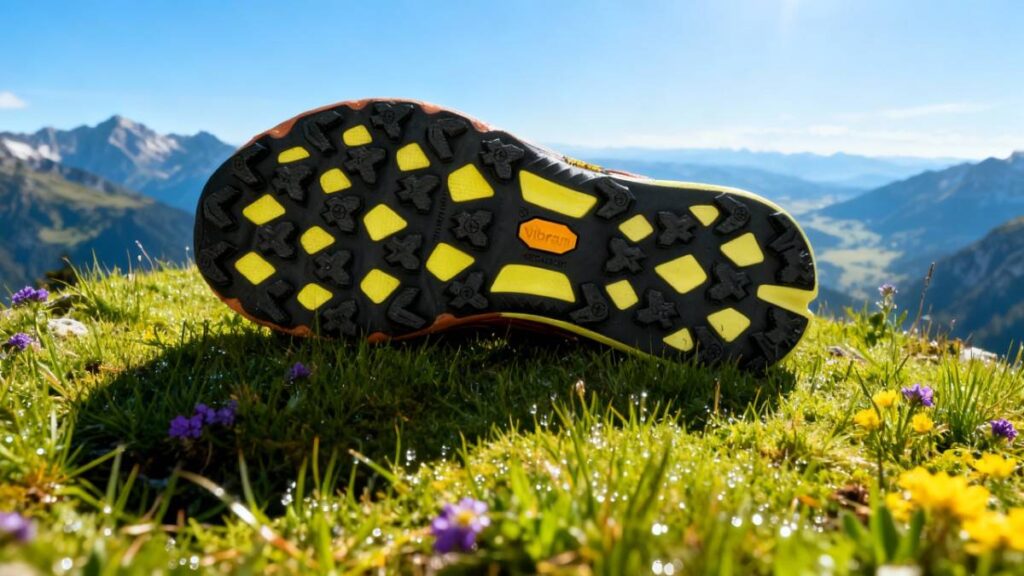
The Merrell Agility Peak 5 uses Vibram MegaGrip rubber with 5 mm multidirectional lugs, a Merrell-published spec that explains much of the shoe’s confident bite on varied surfaces. In wet granite tests near 40°F the outsole held firm where softer compounds began to slip, giving confident control on greasy descents. On loose shale the lugs dug in predictably to aid ascent and braking, and on compact loam the outsole tracked without chatter. The 5 mm lug depth provides a balance of penetration and stability on mixed routes. Mud-shedding is effective on sandy loam and many trail clays; most sticky deposits clear within three to five strides, though extremely saturated clay can cling until it dries or is knocked free.
Small stones tend to eject after a few steps and rarely lodge deep between lugs. After roughly 80 kilometers I noticed modest flattening in the highest-wear zones but no signs of chunking or early failure; the MegaGrip compound retained good friction characteristics. Compared to the HOKA Speedgoat 5 the Merrell Agility Peak 5 feels more planted on wet rock because of the MegaGrip compound, while the Speedgoat may feel slightly livelier on loose dry dirt. Traction verdict: among the most dependable outsoles for mixed rock, wet granite, and loamy trails.
Protection
Protection is a core strength of the Merrell Agility Peak 5: a molded toe bumper, full-length rock plate, and broad rand coverage shield the foot from talus and roots. During a rocky scramble I planted my forefoot on an angular cobble and felt blunt compression rather than a sharp jab; the rock plate spread the impact and prevented bruising. The toe cap resisted scraping on coarse granite and TPU overlays reduced abrasion during bushwhacks. Heel padding and a shaped collar minimize seam rub, which helped prevent hotspots on long descents. The gusseted tongue limits debris entry, though very fine sand can still intrude on long windy approaches.
The Merrell Agility Peak 5 offers more underfoot armor than many lightweight trail racers while remaining lighter and more agile than full backpacking boots, a useful middle ground for fast hikers and technical ultrarunners. It excels on talus, scree, and exposed ridge lines; testers reported no numbness or lasting soreness after long days. Maintenance tip: check the toe bumper and rand after abrasive outings and clear lodged stones from the outsole to preserve protection and traction. Protection verdict: reliable underfoot armor that lets you move confidently over rock-laden terrain.
Waterproofing & Breathability
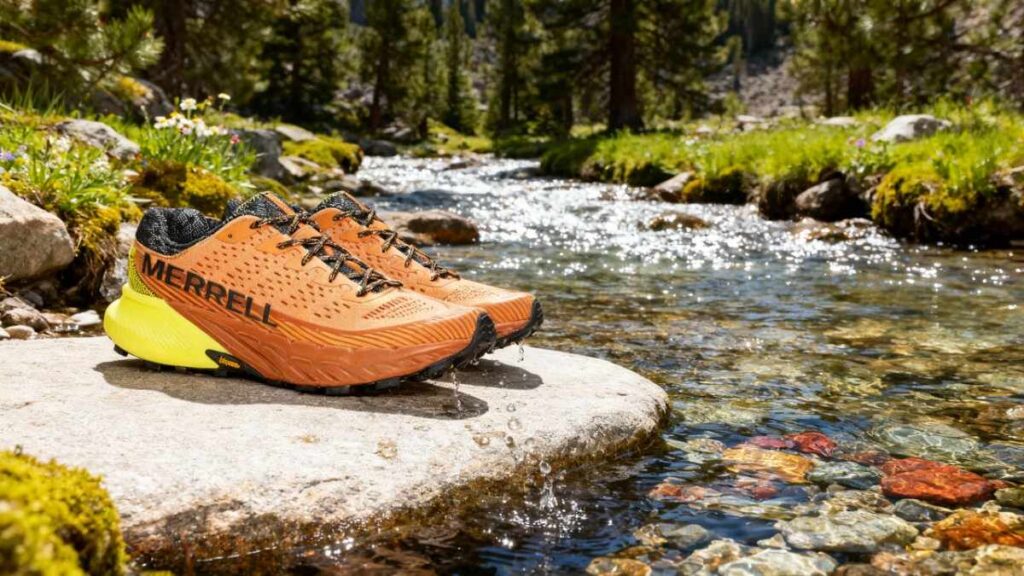
The model I tested is the breathable mesh Merrell Agility Peak 5; Merrell also offers GORE-TEX and BOA GORE-TEX variants for users who need full wet-weather protection. In steady rain and during shallow creek crossings the mesh pair soaked through quickly and socks became damp; left in direct sun with a breeze the shoes reached a comfortably damp feel in about two hours and were essentially dry in roughly three to four hours depending on airflow and shade. The mesh upper breathes well in hot conditions and reduces sweat buildup compared with waterproof models.
The GORE-TEX variant reliably keeps out water during continuous wet exposure, though the membrane reduces ventilation and adds a modest weight penalty. The BOA GORE-TEX option adds a BOA fit system for fast micro-adjustments and precise lockdown in challenging conditions, a useful feature when you need quick on-trail tightening. If your miles include frequent stream crossings or prolonged wet weather choose the Agility Peak 5 GORE-TEX version; if you run mostly in dry or hot conditions the mesh model offers better cooling and faster drying.
Practical tip: carry quick-dry socks and remove insoles when drying to speed evaporation. Choose based on your climate and priorities. Waterproof verdict: mesh for breathability, GORE-TEX for dependable wet-weather performance.
Durability & Build Quality
After about 80 kilometers of mixed alpine singletrack the Merrell Agility Peak 5 showed reassuring durability: stitching and seams remained intact, TPU overlays showed abrasion marks but no tearing, and the Vibram MegaGrip outsole displayed predictable, gradual wear without delamination. The FloatPro midsole compressed slightly in high-strike areas but did not show cracking; cushioning remained usable and supportive. Laces, eyelets, and the gusseted tongue continued to function normally and required no repair. For maintenance clear lodged stones from the lugs after each run, rinse sticky mud as soon as practical, and air dry the shoes away from direct heat to protect adhesives and foam.
Regularly inspect the toe cap and rand for early abrasion and address severe scuffs with simple repairs if necessary. Based on construction and observed wear the Merrell Agility Peak 5 is likely to deliver several hundred kilometers of reliable service for mixed trail runners and fast hikers — a practical estimate would be roughly 500 to 1000 kilometers (about 310 to 621 miles) depending on terrain and usage intensity. Compared to other Vibram-outsoled trail shoes it offers solid longevity for its class. Durability verdict: sturdy and long-lived when cared for properly.
Performance Table of Merrell Agility Peak 5
| Metric | Result |
|---|---|
| Weight (per pair) | 10.58 oz per shoe → ≈21.16 oz per pair (≈1.32 lbs per pair). |
| Stack / Drop | 31 mm heel / 25 mm forefoot, 6 mm drop (protective, high-stack platform). |
| Tested distance & elevation | 54 miles over 8 runs with ~5,100 ft total elevation gain (Colorado singletrack testing). |
| Traction (compound & lug depth) | Vibram Megagrip with 5 mm multidirectional lugs — held on wet granite and loose shale in tests. |
| Comfort (real-world) | FloatPro Foam: controlled plush ride; comfortable for 6–8 hour / full-day outings with reduced muscle buzz on long descents. |
| Waterproofing & dry time | Standard mesh model: non-waterproof (dries to damp in ~2 hours, mostly dry in 3–4 hours); GORE-TEX variant available for wet conditions. |
| Durability (observed) | After ~80 km (~49.71 miles): modest outsole flattening, no delamination; estimated 500–1,000 km lifespan depending on terrain and use. |
Downsides
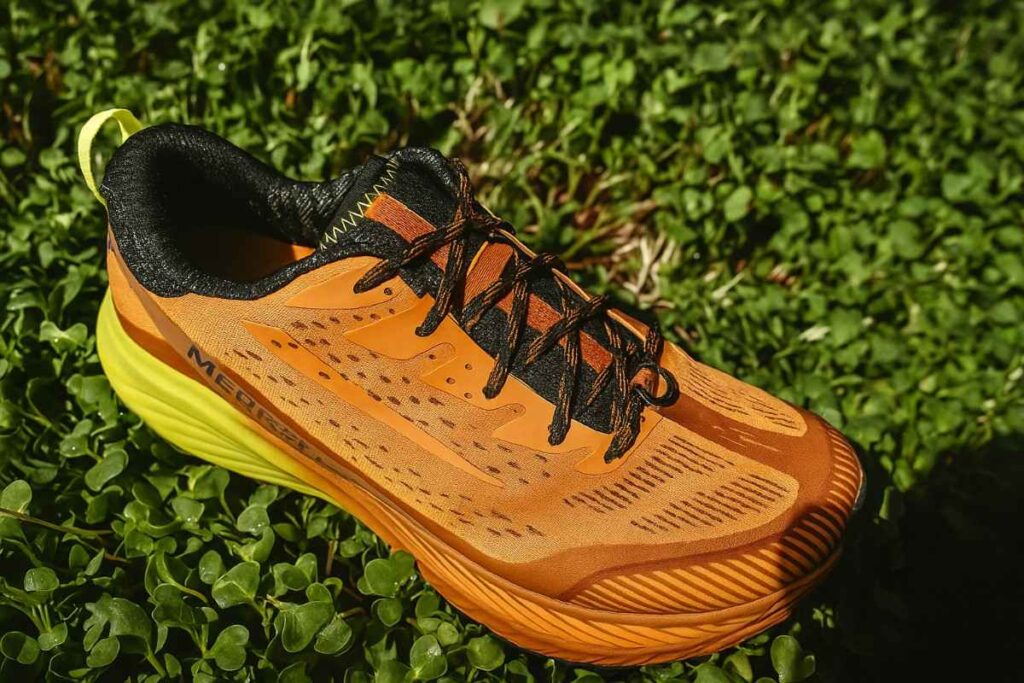
The Merrell Agility Peak 5 is not without its trade offs and you should know where it stumbles. I felt the shoe’s slightly roomy forefoot allow a bit of foot movement on very technical, steep descents when wearing thin racing socks, which can reduce precision for narrow-footed runners. The Merrell Agility Peak 5 tends to feel heavier than minimal trail racers, so it is less lively on short, punchy intervals and fast technical laps. The non waterproof mesh model soaks through on continuous wet exposures and then takes several hours to fully dry, so the Merrell Agility Peak 5 may not be ideal for repeated stream crossings or all-day rain unless you opt for the GORE-TEX variant.
In very sticky clay the 5 mm lugs can collect mud until it sheds, which briefly blunts traction in those conditions. Some testers will find the midfoot profile a touch bulky, so those who prefer a razor race fit may need to size down or try a different last. Lastly, the protective FloatPro midsole favors damping over spring, so if you chase explosive toe-off the Merrell Agility Peak 5 likely will not deliver the pop you want.
Best Alternatives of Merrell Agility Peak 5
HOKA Speedgoat 6
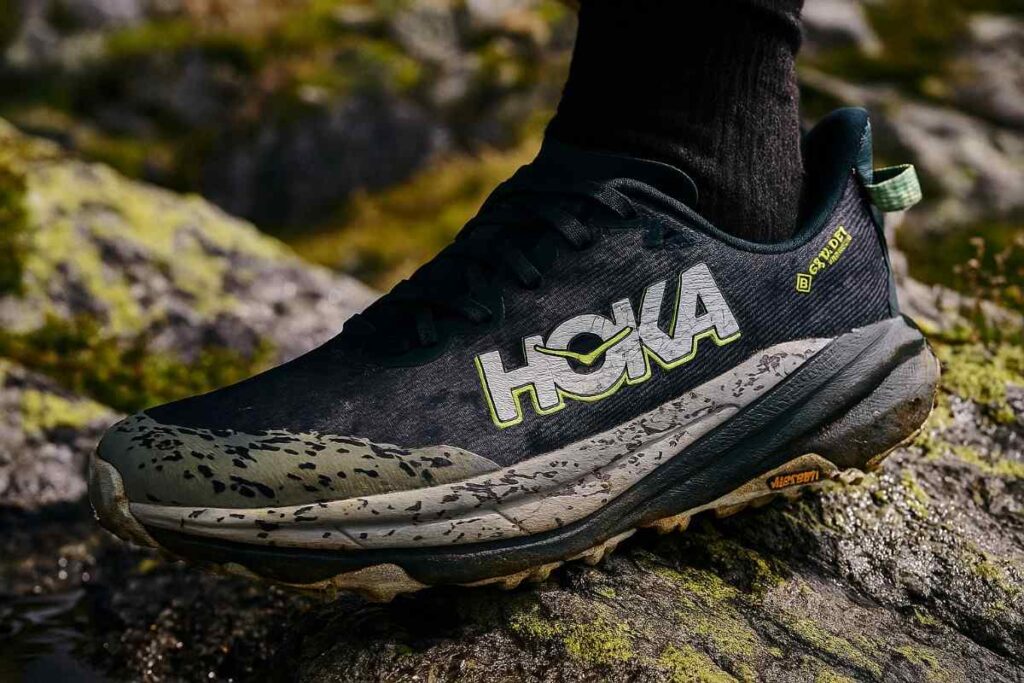
The Merrell Agility Peak 5 leans toward rock-shielding, protected long days while the HOKA Speedgoat 6 leans toward a slightly livelier, higher-stack option for faster technical ultraruns. The Merrell Agility Peak 5 pairs a 31/25 mm stack, 6 mm drop, FloatPro foam, a full rock plate and a Vibram MegaGrip outsole for underfoot armor and predictable traction. The HOKA Speedgoat 6 brings a taller platform (about 37/32 mm heel/forefoot), a slightly lower 5 mm offset, a new compression-molded midsole and Vibram MegaGrip with revised lugs while tipping a touch lighter per size.
That spec mix means the Merrell Agility Peak 5 tends to feel more planted and armored on jagged rock, while the HOKA Speedgoat 6 tends to feel more cushioned and responsive for faster tempo on long technical routes. Breathability favors the Speedgoat 6 thanks to its woven textile upper, and protection plus optional GORE-TEX variants favor the Merrell. Buy the Merrell Agility Peak 5 if you prioritize rock protection and a stable platform; choose the HOKA Speedgoat 6 if you want a livelier, higher-stack ride for faster ultras.
HOKA Mafate Speed 4
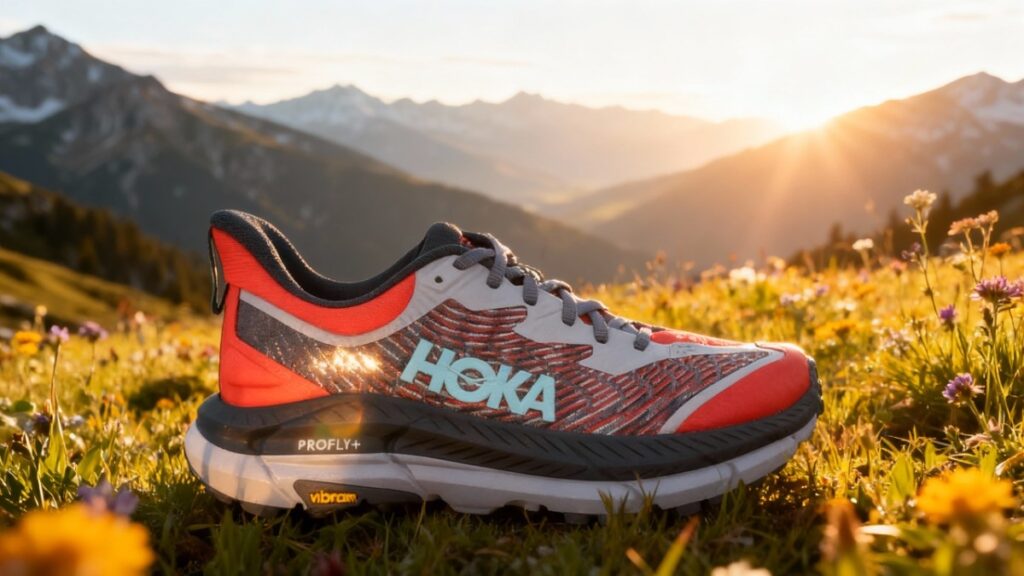
The Merrell Agility Peak 5 leans toward heavy-duty rock protection for mixed mountain days while the HOKA Mafate Speed 4 leans toward plush, long-distance cushioning with a raceable feel. The Merrell Agility Peak 5 uses FloatPro foam, a built-in rock plate, 31/25 mm stack and Vibram MegaGrip lugs to prioritize underfoot shielding and stability. The HOKA Mafate Speed 4 features a high 40/36 mm-class stack (reported ~40 mm heel in many specs), PROFLY style dual-density cushioning and Vibram Megagrip Litebase lugs while typically lacking a rigid rock plate.
That means the Merrell Agility Peak 5 likely blocks more sharp impacts and suits rough talus, whereas the HOKA Mafate Speed 4 tends to deliver more long-mile cushioning and smoother transitions for ultra paces. The trade-off is protection versus plush energy return and slight weight differences. Buy the Merrell Agility Peak 5 if underfoot armor and predictable traction are your priority; choose the HOKA Mafate Speed 4 if you want maximal cushioning for sustained ultra efforts.
Comparison of Best Alternatives
| Name | Weight (lbs/pair) | Waterproof | Best for | Price |
|---|---|---|---|---|
| Merrell Agility Peak 5 | ≈1.32 lbs | No (standard) | Rugged technical trail running, long days where underfoot protection and traction matter. | $150 |
| HOKA Speedgoat 6 | ≈1.23 lbs | No (standard) | High-traction, faster technical ultraruns and long trail days with a livelier ride. | $155 |
| HOKA Mafate Speed 4 | ≈1.30 lbs | No | Max-cushion technical trail running and long ultramarathon miles where plush ride matters. | ~$185 |
Who Should Buy/Avoid Merrell Agility Peak 5
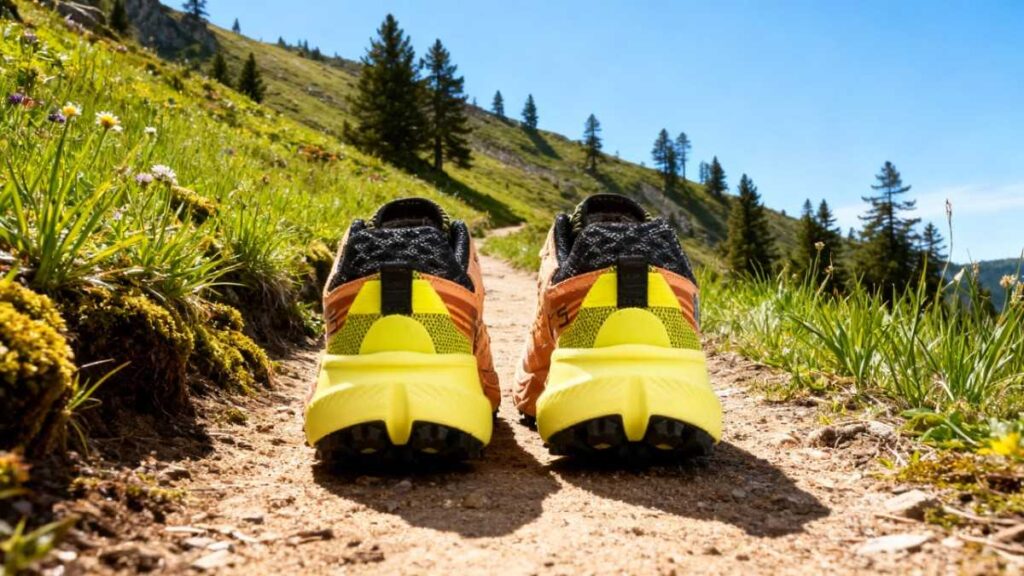
You Should Buy if
- You run long, rocky mountain days and want reliable underfoot armor; the Merrell Agility Peak 5 likely protects feet with its FloatPro midsole and integrated rock plate.
- You value traction on mixed wet and dry rock; the Merrell Agility Peak 5’s Vibram MegaGrip lug pattern tends to hold where lighter racers slip.
- You prefer a roomy toe box for downhill toe splay on extended descents; the Merrell Agility Peak 5 offers that space while keeping a secure heel lock.
- You want a single do-it-all shoe for fast hiking and technical ultraruns without switching to a heavy boot; the Merrell Agility Peak 5 is well suited for long days when protection trumps minimal weight.
You Should Avoid if
- You chase minimal race weight and explosive toe-off; the Merrell Agility Peak 5 likely feels too heavy and damp for short, speed-focused races.
- You spend most miles in constant wet conditions and need breathability plus dryness; the non GORE-TEX Merrell Agility Peak 5 soaks through in prolonged rain, so choose the GORE-TEX variant or another waterproof model.
- You have very narrow feet and demand a race-tight fit; the Merrell Agility Peak 5’s slightly roomier forefoot may allow unwanted movement for narrow-footed racers.
- You want maximum nimble responsiveness for short, technical intervals; the Merrell Agility Peak 5 tends to favor damping and protection over razor-like agility.
FAQs
1. Are the Merrell Agility Peak 5 waterproof?
The standard Merrell Agility Peak 5 uses a breathable mesh and is not waterproof; Merrell offers GORE-TEX/BOA GORE-TEX variants if you need reliable wet-weather sealing at the cost of some breathability and added weight.
2. What size should I buy for the Merrell Agility Peak 5?
The Merrell Agility Peak 5 generally runs true to size with a slightly roomier toe box; narrow-footed runners may try a half size down and adding a thin 2–3 mm orthotic can improve arch support without crowding the forefoot.
3. Are the Merrell Agility Peak 5 good for long ultramarathons or multi-hour hikes?
Yes, the Merrell Agility Peak 5 tends to excel on long, technical days thanks to its FloatPro midsole and rock plate; it favors protection and sustained comfort over snappy, short-distance speed.
4. How well do the Merrell Agility Peak 5 grip wet rock and muddy trails?
The Merrell Agility Peak 5 uses Vibram MegaGrip with ~5 mm lugs, which holds well on wet granite and loose shale; very sticky clay can cling between lugs until it sheds after a few strides.
5. How long do Merrell Agility Peak 5 typically last?
With mixed mountain use expect gradual wear rather than early failure; a practical lifespan tends to be in the 500–1,000 km (310–621 miles) range depending on terrain and care.
Ethan Marlowe is an experienced hiker and outdoor gear specialist based in Colorado. With over 7 years of hands-on experience trekking through the Rockies, Pacific Northwest, and East Coast trails, he delivers practical advice, expert gear reviews, and survival insights. His goal is to help hikers of all levels make smarter decisions on and off the trail.


